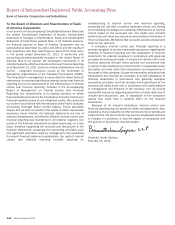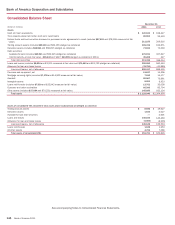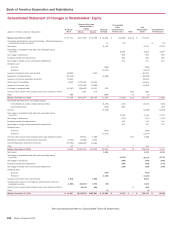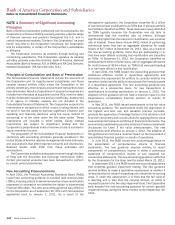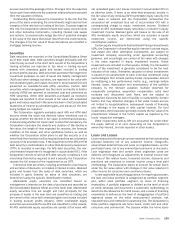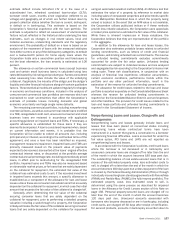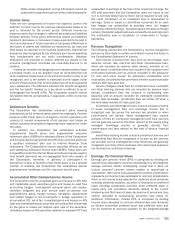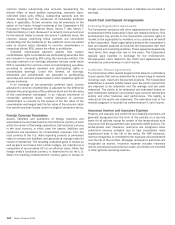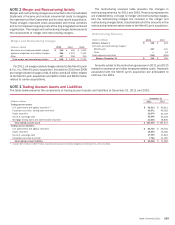Bank of America 2011 Annual Report Download - page 158
Download and view the complete annual report
Please find page 158 of the 2011 Bank of America annual report below. You can navigate through the pages in the report by either clicking on the pages listed below, or by using the keyword search tool below to find specific information within the annual report.156 Bank of America 2011
portfolio segment are core portfolio residential mortgage, Legacy
Asset Servicing residential mortgage, Countrywide Financial
Corporation (Countrywide) residential mortgage purchased credit-
impaired (PCI), core portfolio home equity, Legacy Asset Servicing
home equity, Countrywide home equity PCI, Legacy Asset Servicing
discontinued real estate and Countrywide discontinued real estate
PCI. The classes within the credit card and other consumer portfolio
segment are U.S. credit card, non-U.S. credit card, direct/indirect
consumer and other consumer. The classes within the commercial
portfolio segment are U.S. commercial, commercial real estate,
commercial lease financing, non-U.S. commercial and U.S. small
business commercial.
Purchased Credit-impaired Loans
The Corporation purchases loans with and without evidence of
credit quality deterioration since origination. Evidence of credit
quality deterioration as of the purchase date may include statistics
such as past due status, refreshed borrower credit scores and
refreshed loan-to-value (LTV) ratios, some of which are not
immediately available as of the purchase date. Purchased loans
with evidence of credit quality deterioration for which it is probable
that the Corporation will not receive all contractually required
payments receivable are accounted for as PCI loans. The excess
of the cash flows expected to be collected on PCI loans, measured
as of the acquisition date, over the estimated fair value is referred
to as the accretable yield and is recognized in interest income over
the remaining life of the loan using a level yield methodology. The
difference between contractually required payments as of the
acquisition date and the cash flows expected to be collected is
referred to as the nonaccretable difference. PCI loans that have
similar risk characteristics, primarily credit risk, collateral type and
interest rate risk, are pooled and accounted for as a single asset
with a single composite interest rate and an aggregate expectation
of cash flows.
The Corporation continues to estimate cash flows expected to
be collected over the life of the loan using internal credit risk,
interest rate and prepayment risk models that incorporate
management’s best estimate of current key assumptions such as
default rates, loss severity and payment speeds. If, upon
subsequent evaluation, the Corporation determines it is probable
that the present value of the expected cash flows have decreased,
the PCI loan is considered further impaired resulting in a charge
to the provision for credit losses and a corresponding increase to
a valuation allowance included in the allowance for loan and lease
losses. If, upon subsequent evaluation, it is probable that there
is an increase in the present value of the expected cash flows,
the Corporation reduces any remaining valuation allowance. If
there is no remaining valuation allowance, the Corporation
recalculates the amount of accretable yield as the excess of the
revised expected cash flows over the current carrying value
resulting in a reclassification from nonaccretable difference to
accretable yield. The present value of the expected cash flows is
determined using the PCI loans’ effective interest rate, adjusted
for changes in the PCI loans’ interest rate indexes.
Loan disposals, which may include sales of loans, receipt of
payments in full from the borrower or foreclosure, result in removal
of the loan from the PCI loan pool. Write-downs are not recorded
on the PCI loan pool until actual losses exceed the remaining
nonaccretable difference. To date, no write-downs have been
recorded for any of the PCI loan pools.
Leases
The Corporation provides equipment financing to its customers
through a variety of lease arrangements. Direct financing leases
are carried at the aggregate of lease payments receivable plus
estimated residual value of the leased property less unearned
income. Leveraged leases, which are a form of financing leases,
are carried net of nonrecourse debt. Unearned income on
leveraged and direct financing leases is accreted to interest
income over the lease terms using methods that approximate the
interest method.
Allowance for Credit Losses
The allowance for credit losses, which includes the allowance for
loan and lease losses and the reserve for unfunded lending
commitments, represents management’s estimate of probable
losses inherent in the Corporation’s lending activities. The
allowance for loan and lease losses and the reserve for unfunded
lending commitments exclude amounts for loans and unfunded
lending commitments accounted for under the fair value option as
the fair values of these instruments reflect a credit component.
The allowance for loan and lease losses does not include amounts
related to accrued interest receivable other than billed interest
and fees on credit card receivables as accrued interest receivable
is reversed when a loan is placed on nonaccrual status. The
allowance for loan and lease losses represents the estimated
probable credit losses on funded consumer and commercial loans
and leases while the reserve for unfunded lending commitments,
including standby letters of credit (SBLCs) and binding unfunded
loan commitments, represents estimated probable credit losses
on these unfunded credit instruments based on utilization
assumptions. Credit exposures deemed to be uncollectible,
excluding derivative assets, trading account assets and loans
carried at fair value, are charged against these accounts. Cash
recovered on previously charged off amounts is recorded as a
recovery to these accounts. Management evaluates the adequacy
of the allowance for credit losses based on the combined total of
the allowance for loan and lease losses and the reserve for
unfunded lending commitments.
The Corporation performs periodic and systematic detailed
reviews of its lending portfolios to identify credit risks and to
assess the overall collectability of those portfolios. The allowance
on certain homogeneous consumer loan portfolios, which
generally consist of consumer real estate within the home loans
portfolio segment and credit card loans within the credit card and
other consumer portfolio segment, is based on aggregated
portfolio segment evaluations generally by product type. Loss
forecast models are utilized for these portfolios which consider a
variety of factors including, but not limited to, historical loss
experience, estimated defaults or foreclosures based on portfolio
trends, delinquencies, bankruptcies, economic conditions and
credit scores.
The Corporation’s home loans portfolio segment is comprised
primarily of large groups of homogeneous consumer loans secured
by residential real estate. The amount of losses incurred in the
homogeneous loan pools is estimated based upon how many of
the loans will default and the loss in the event of default. Using
statistically valid modeling methodologies, the Corporation
estimates how many of the homogeneous loans will default based
on the individual loans’ attributes aggregated into pools of
homogeneous loans with similar attributes. The attributes that are
most significant to the probability of default and are used to


